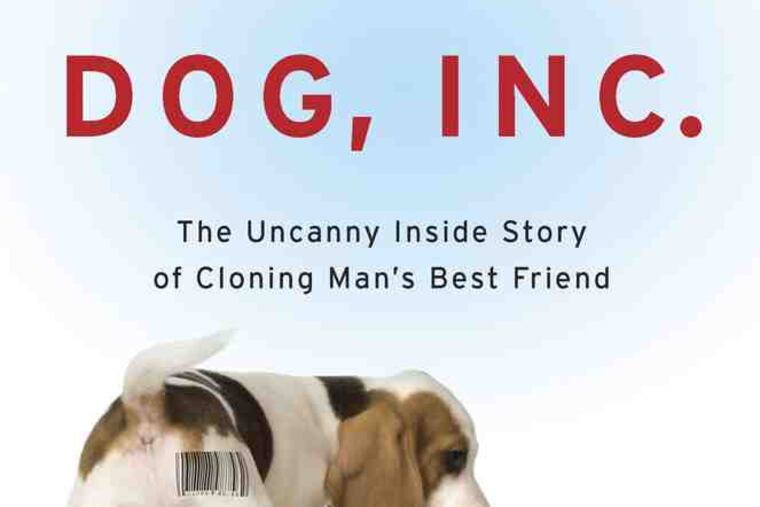Cloning dogs: The true tale
Colorful human characters are as much a part of it as the laboratory-created canines.

The Uncanny Inside Story
of Cloning Man's Best Friend
By John Woestendiek
Avery Books. 310 pp. $26
nolead ends nolead begins
Reviewed by Mike Weilbacher
The century ahead holds a wide range of challenges that cut across science and ethics: Global warming, health care for an aging and increasingly obese population, irrevocable loss of species, stem cell research that may lead to cures for previously untreatable diseases, ever more complicated transplants of organs and limbs, reproduction of genetic material for commercial gain.
And cloning.
You probably remember Dolly, the sheep cloned in 1996, produced to astonishing attention and named in honor of country singer Dolly Parton. But in the 15 years since, science has quietly cloned a surprisingly long list of mammals: mice, cattle, pigs, goats, cats, even wolves, and there is serious talk of saving highly endangered species such as Bengal tigers through cloning.
While we haven't cloned humans, we seem to be working our way up the ladder, and our culture has never had the full-throated discussion of cloning that we've had with, say, abortion, or even evolution.
Into the cloning story steps investigative reporter John Woestendiek, who won a Pulitzer Prize in 1987 for his prison reporting for The Inquirer. A veteran journalist whose most recent stint was at the Baltimore Sun, Woestendiek now blogs at both www.ohmidog!.com, the self-described "site for dog lovers," and www.travelswithace.com, where he recounts a journey with a dog named Ace that was inspired by John Steinbeck's Travels With Charley.
So, Woestendiek brings a knowledge of dogs to Dog, Inc., a fast-paced account of the race between teams of scientists to be the first to commercially clone a dog. Though the book is a well-researched work of nonfiction, it has the kind of outrageously outsized personalities, which cloning seems to attract, that you'd expect in a David Lynch movie.
There's Bernann McKinney, the emotionally overwrought comic-tragic former beauty queen who travels to a South Korean lab to pick up five puppy clones of Booger, her beloved pit bull of blessed memory. They were the world's first successful commercial dog clones, and McKinney, though virtually penniless, agreed to pay $150,000 for them. She was adamant that the pups would not fly home in cargo and hatched an increasingly sad series of plans to bring the dogs back in the plane's main cabin.
And there's Claude Vorilhon, the Frenchman who founded the Raelian cult centered on UFO worship, builder of a failed UFO theme park in Quebec, and fervent cloner. He believes that at the world's end, aliens will bring the best of us back as clones. The Raelians launched Clonaid, a project intent on cloning humans; by 2001, they had even found a West Virginia lawyer gullible enough to pay the firm to produce a clone of his dead infant son. Though Clonaid insists it has cloned humans, proof has never been presented.
Then there's John Sperling, billionaire founder of the University of Phoenix. Inspired by Dolly, he set up a company to clone his girlfriend's dog Missy. Dubbed the Missyplicity project, the group sets up shop at Texas A&M and gets its legs under it by cloning Chance, a big, famously gentle Brahma bull owned by former rodeo clown Ralph Fisher, part of a menagerie of Texas animals that travels to Super Bowls, All-Star Games, and TV shows such as The Late Show With David Letterman. Fisher persuades the scientists to clone Chance - and Second Chance is born.
You can't make this stuff up.
Woestendiek expertly weaves multiple story lines, deftly creating a cloak that fairly covers the entire story. And he has pulled off a difficult feat, writing a science book that's highly entertaining.
But as well written as Dog, Inc. is, there's an element of sadness to it.
Several key scientists involved in cloning are described by Woestendiek as talented but ethically challenged. Their ethical lapses include fudging data and paying (or possibly extorting) female employees to offer their own eggs for stem-cell experiments. Snuppy, an Afghan that is the first successfully cloned dog, lives alone in a lab at Seoul National University, "rail-thin and exceedingly vocal." McKinney's life story occupies too large a chunk of the book's real estate, her arc descending into something you'd expect from the National Enquirer, her five puppies bundles of health issues. Second Chance is not gentle at all, almost killing Ralph twice, and dies young (as does Dolly herself).
And while Missy is successfully cloned, Woestendiek writes that "the flabbergasting fact was, after eleven years of research on two continents; after all the trials and errors; after all the testing, harvesting, micromanipulation, zapping, implanting, and legal wrangling; after an estimated $20 million of her friend's money poured into creating a clone of Missy, [she] didn't want the dog." Sperling's company pulls out of dog cloning.
Far from any Brave New World, cloning, at least among dogs, feels like a scientific dead end, a cul-de-sac.
And with all the other bioethical issues facing us, that may be a good thing.